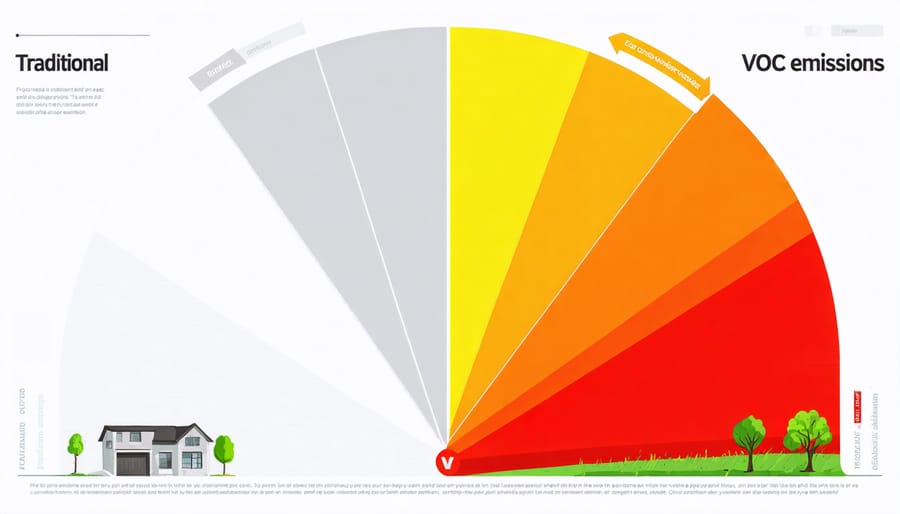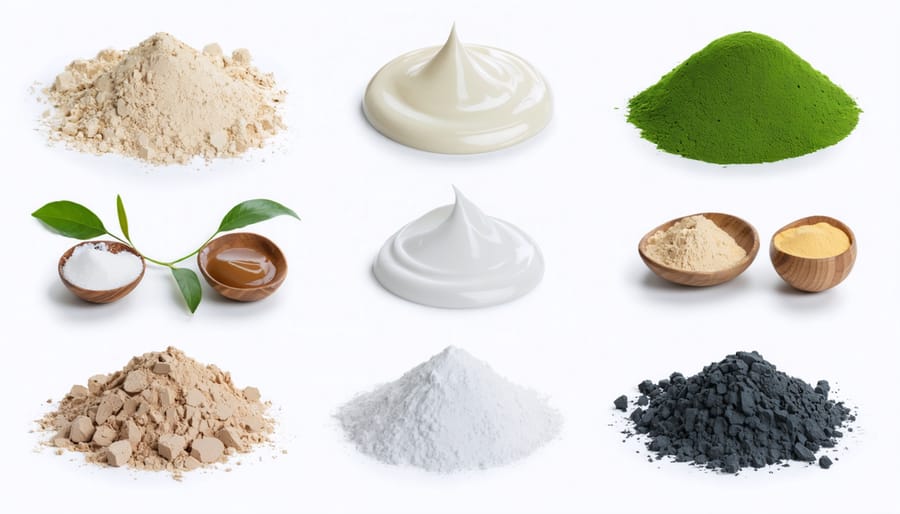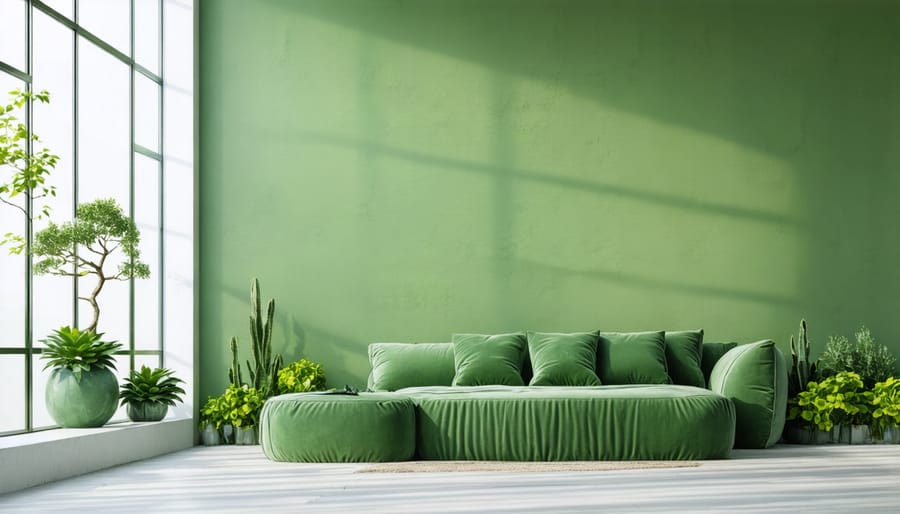Transform your living space with eco-friendly paint that protects both your family’s health and the environment. Unlike conventional paints that release harmful volatile organic compounds (VOCs) for years after application, natural and low-VOC alternatives create a safer, more sustainable home environment while delivering stunning aesthetic results.
Today’s eco-friendly paints offer remarkable innovations: milk-based formulas that create durable, richly-pigmented finishes; mineral-based options that naturally resist mold; and plant-derived solutions that actually help purify indoor air. These environmentally conscious choices not only minimize your carbon footprint but also provide superior coverage and breathability compared to traditional chemical-based paints.
Whether you’re refreshing a bedroom, updating your kitchen, or tackling a full home renovation, choosing eco-friendly paint represents a powerful step toward sustainable living. Beyond the immediate visual impact, these natural alternatives eliminate that distinctive “new paint smell” – actually a warning sign of toxic emissions – while supporting better indoor air quality for years to come. The best part? Modern eco-friendly formulations now match or exceed conventional paints in durability, color selection, and ease of application, making the choice to go green easier than ever.
What Makes Paint Eco-Friendly?
Low or Zero VOCs
When it comes to eco-friendly paint, one of the most important factors to consider is VOC content. VOCs (Volatile Organic Compounds) are harmful chemicals that evaporate into the air as paint dries, affecting both indoor air quality and the environment. These compounds can cause headaches, respiratory issues, and even contribute to smog formation outdoors.
The good news is that many manufacturers now offer zero VOC materials and low-VOC paint options that are just as effective as traditional paints. While standard paints can contain up to 150 grams of VOCs per liter, low-VOC paints contain less than 50 grams per liter, and zero-VOC options have less than 5 grams per liter.
By choosing paints with lower VOC levels, you’re not only protecting your family’s health but also contributing to a cleaner environment. These eco-friendly alternatives perform excellently, offering the same durability and coverage as conventional paints while letting you breathe easier during and after your painting project. Plus, they typically have little to no paint smell, making them perfect for bedrooms, nurseries, and other sensitive spaces.

Natural Ingredients
Natural paint ingredients have come a long way, offering beautiful results while being kind to both your health and the environment. Clay, milk protein (casein), chalk, and natural oils like linseed and citrus form the foundation of eco-friendly paints. These ingredients replace harmful volatile organic compounds (VOCs) found in conventional paints, making them safer for indoor air quality.
Plant-based pigments and minerals provide rich, lasting colors without synthetic dyes. For example, ochre creates warm yellows and reds, while indigo offers beautiful blues. Many eco-friendly paints also incorporate sustainable binders like tree resins and vegetable-derived solutions that help the paint adhere effectively to surfaces.
What’s particularly exciting is how these natural ingredients often perform better than their synthetic counterparts. Lime-based paints, for instance, naturally resist mold and mildew growth. Meanwhile, clay paints help regulate indoor humidity levels, creating a more comfortable living environment.
Look for paints featuring ingredients like titanium dioxide from natural sources, which provides excellent coverage without harmful mining practices. Remember, the best eco-friendly paints combine these natural elements with innovative processing methods to deliver both environmental benefits and superior performance.

Top Eco-Friendly Paint Options
Mineral-Based Paints
Mineral-based paints offer a fantastic natural alternative that aligns perfectly with other sustainable home materials. These paints are made primarily from natural minerals like clay, chalk, and lime, creating a breathable finish that’s ideal for both interior and exterior surfaces. What makes them particularly special is their ability to regulate moisture, which helps prevent mold growth and maintains better indoor air quality.
Unlike conventional paints, mineral paints bond chemically with the surface they’re applied to, resulting in exceptional durability and fade resistance. They’re naturally alkaline, which means they resist bacterial growth without harmful additives. While they might cost a bit more initially, their long-lasting nature and minimal maintenance requirements make them a cost-effective choice in the long run.
The best part? These paints are completely free from petrochemicals and release virtually no VOCs, making them safe for your family and the environment.
Plant-Based Paints
Plant-based paints offer a beautiful, natural alternative to conventional options, drawing their color and binding properties from sustainable sources like linseed oil, clay, citrus, and plant resins. These paints are completely biodegradable and emit virtually no harmful VOCs, making them an excellent choice for environmentally conscious homeowners.
Popular plant-based ingredients include milk protein (casein), which creates a durable finish, and natural oils like hemp and soy that provide excellent coverage. Many manufacturers now offer vibrant color options derived from botanical sources such as beetroot, indigo, and turmeric, proving that eco-friendly doesn’t mean compromising on style.
While plant-based paints may require more frequent maintenance than conventional options, they offer superior breathability for your walls and are particularly well-suited for historic homes and natural building materials. They’re also safe to dispose of and won’t harm soil or water systems, making them truly earth-friendly from production to disposal.
Milk-Based Paints
Milk-based paints, also known as casein paints, have been used for centuries and are making a comeback in eco-conscious homes. These paints are made from milk protein (casein), lime, clay, and natural pigments, creating a durable, non-toxic finish that’s perfect for indoor use. The result is a beautiful matte finish with a depth of color that’s hard to achieve with conventional paints.
One of the best things about milk paint is its zero-VOC content and biodegradable nature. It’s so safe that you could technically compost your leftover paint! While traditional milk paint comes in powder form that you mix with water, several manufacturers now offer premixed versions for easier application.
Keep in mind that milk paint has a unique, somewhat rustic appearance that may show slight variations in color and texture. This characteristic makes it particularly popular for furniture restoration and creating vintage-inspired looks. For best results, seal your milk paint with natural wax or oil, especially in high-traffic areas or on surfaces that might be exposed to moisture.
Recycled Paints
Did you know that recycled paint is a fantastic eco-friendly option that often costs 50-75% less than new paint? These paints are created by collecting and reprocessing unused or leftover paint, giving them a second life while keeping them out of landfills. The process involves careful screening, filtering, and blending to create high-quality products that meet industry standards.
Many municipalities and paint manufacturers now offer recycled paint programs, making it easier than ever to access these sustainable options. While color selection might be more limited compared to traditional paints, recycled paints typically come in popular neutral shades perfect for most home projects.
The quality of recycled paint has improved significantly in recent years, with many products performing just as well as their non-recycled counterparts. They’re particularly great for large interior projects, garages, and outdoor structures. Before purchasing, check the paint’s coverage and finish specifications, as these can vary between manufacturers and batches.
Practical Tips for Using Eco-Friendly Paint

Surface Preparation
Proper surface preparation is essential for achieving a beautiful, long-lasting finish with your eco-friendly paint. Start by thoroughly cleaning the surface to remove dirt, dust, and grease using a mixture of warm water and gentle, biodegradable soap. For tougher stains, try natural cleaning solutions like vinegar or baking soda paste instead of harsh chemical cleaners.
Next, inspect the surface for any damage. Fill holes and cracks with eco-friendly spackle or natural wood filler, and sand the patches smooth once dry. For walls, repair any loose tape or crumbling drywall before proceeding. When sanding, always wear a dust mask and work in a well-ventilated area.
Remove any loose or peeling paint using a scraper or wire brush. If you’re working with older surfaces, consider having them tested for lead paint first, especially in homes built before 1978. For glossy surfaces, create a slightly rough texture by sanding to help the new paint adhere better.
Finally, protect surrounding areas by covering floors and furniture with reusable drop cloths or old sheets rather than disposable plastic covers. Apply eco-friendly painter’s tape to trim and edges, and ensure proper ventilation by opening windows and doors. Remember to clean your tools with warm water and mild soap before starting, as residual chemicals could contaminate your eco-friendly paint.
Application Techniques
Applying eco-friendly paint requires slightly different techniques compared to conventional paints for the best results. Start by thoroughly cleaning and preparing your surfaces – this is especially important as many eco-friendly paints don’t contain the harsh binding agents found in conventional options.
Before painting, stir your eco-paint thoroughly but gently. Unlike traditional paints, avoid vigorous shaking as this can affect the natural ingredients’ consistency. Apply the paint in thin, even coats using high-quality brushes or rollers made from natural materials for the best finish.
Many eco-friendly paints have a shorter drying time between coats, typically 2-4 hours. However, always check the manufacturer’s specific instructions, as natural ingredients can behave differently under various conditions. Work in well-ventilated areas, even though these paints have minimal VOCs.
For best coverage, most eco-friendly paints require 2-3 coats. Apply each coat in the same direction and maintain a “wet edge” to avoid lap marks. Since these paints often have a different texture, use long, smooth strokes rather than short, choppy ones.
Remember to clean your tools immediately after use with warm water and mild soap – most eco-friendly paints are water-based and will wash out easily while wet. Store any leftover paint in an airtight container in a cool, dry place to maintain its natural properties.
Cost Considerations and Long-Term Benefits
While eco-friendly paint typically costs 10-25% more than conventional options upfront, the long-term benefits often make it a smart investment for both your wallet and the planet. Let’s break down the cost considerations and explore why this investment pays off over time.
The initial price difference primarily stems from higher-quality ingredients and sustainable manufacturing processes. However, many homeowners find that eco-friendly paints offer superior coverage, often requiring fewer coats than conventional alternatives. This means you might need less paint overall, helping offset the higher per-gallon cost.
Another significant advantage is durability. Eco-friendly paints generally last longer and maintain their color better, reducing the frequency of repainting. This longevity means fewer materials purchased over time and less frequent labor costs, whether you’re hiring professionals or doing it yourself.
Health-related savings are harder to quantify but equally important. Traditional paints can release harmful VOCs (Volatile Organic Compounds) for years after application, potentially leading to health issues and associated medical costs. Eco-friendly paints minimize these risks, contributing to better indoor air quality and overall well-being.
When considering maintenance, eco-friendly paints often prove more cost-effective. Their superior resistance to mold, mildew, and UV damage means less frequent touch-ups and better long-term appearance. This durability makes them particularly valuable in high-moisture areas like bathrooms and kitchens.
As part of broader eco-friendly home solutions, these paints can contribute to better resale value. Modern homebuyers increasingly prioritize sustainable features, making eco-friendly paint choices a selling point that could pay off when it’s time to move.
Energy savings might also factor in, as some eco-friendly paints offer better insulative properties and heat-reflective capabilities, potentially reducing heating and cooling costs. While these savings may be modest, they add to the overall value proposition over time.
Remember to factor in local rebates or tax incentives for using environmentally friendly building materials, as these can help offset initial costs. Some municipalities and organizations offer financial incentives for choosing sustainable home improvement options, making the switch to eco-friendly paint even more economical.
Making the switch to eco-friendly paint is more than just a trend – it’s a meaningful step toward creating healthier homes and a more sustainable future. Throughout this guide, we’ve explored how these environmentally conscious paints reduce harmful emissions, protect indoor air quality, and minimize environmental impact through their production and disposal.
Remember that eco-friendly paints offer comparable (and often superior) performance to conventional options, with excellent coverage, durability, and a wide range of beautiful colors. While they may cost slightly more upfront, the benefits to your health, home, and the planet make them a worthwhile investment.
As you embark on your next painting project, consider starting small with a single room to experience the difference firsthand. Pay attention to eco-certifications, VOC content, and natural ingredients when selecting your paint. Don’t forget to properly prepare your surfaces and follow application guidelines for the best results.
By choosing eco-friendly paint, you’re not just decorating your space – you’re contributing to a larger movement toward sustainable living. Whether you’re a seasoned DIY enthusiast or tackling your first painting project, making environmentally conscious choices today helps create a better tomorrow for generations to come. Take that first step toward greener living, one painted wall at a time.
